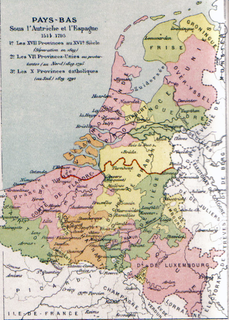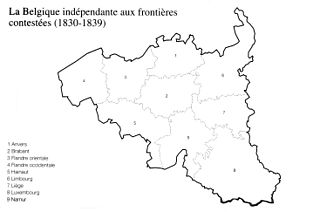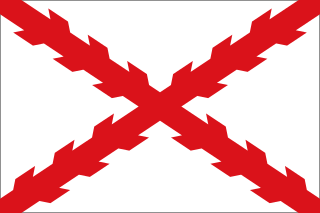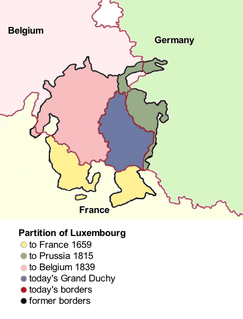Limburg or Limbourg may refer to:

Limburg is the southernmost of the 12 provinces of the Netherlands. It is in the southeastern part of the country, stretched out from the north, where it touches the province of Gelderland, to the south, where it internationally borders Belgium. Its northern part has the North Brabant province to its west. Its long eastern boundary is the international border with the German state of North Rhine-Westphalia. Much of the west border runs along the River Maas, bordering the Flemish province of Limburg, and a small part of the Walloon province of Liège. On the south end, it has borders with the Flemish exclave of Voeren and its surrounding part of Liège, Wallonia. The Vaalserberg is on the extreme south-eastern point, marking the tripoint of Netherlands, Germany and Belgium.

The Meuse or Maas is a major European river, rising in France and flowing through Belgium and the Netherlands before draining into the North Sea from the Rhine–Meuse–Scheldt delta. It has a total length of 925 km.

The United Kingdom of the Netherlands is the unofficial name given to the Kingdom of the Netherlands as it existed between 1815 and 1839. The United Netherlands was created in the aftermath of the Napoleonic Wars through the fusion of territories that had belonged to the former Dutch Republic, Austrian Netherlands, and Prince-Bishopric of Liège. The polity was a constitutional monarchy, ruled by William I of the House of Orange-Nassau.

Limburg is a province in Belgium. It is the easternmost of the five Dutch-speaking provinces that together form the Region of Flanders, one of the three main political and cultural sub-divisions of modern Belgium.

The states of the German Confederation were those member states that from 20 June 1815 were part of the German Confederation, which lasted, with some changes in the member states, until 24 August 1866, under the presidency of the Austrian imperial House of Habsburg, which was represented by an Austrian presidential envoy to the Federal diet in Frankfurt.

The Southern Netherlands, also called the Catholic Netherlands, was the part of the Low Countries largely controlled by Spain (1556–1714), later Austria (1714–1794), and occupied then annexed by France (1794–1815). The region also included a number of smaller states that were never ruled by Spain or Austria: the Prince-Bishopric of Liège, the Imperial Abbey of Stavelot-Malmedy, the County of Bouillon, the County of Horne and the Princely Abbey of Thorn. The Southern Netherlands were part of the Holy Roman Empire until the whole area was annexed by Revolutionary France.

The Treaty of London of 1839, also called the First Treaty of London, the Convention of 1839, the Treaty of Separation, the Quintuple Treaty of 1839, or the Treaty of the XXIV articles, was a treaty signed on 19 April 1839 between the Concert of Europe, the United Kingdom of the Netherlands and the Kingdom of Belgium. It was a direct follow-up to the 1831 Treaty of the XVIII Articles which the Netherlands had refused to sign, and the result of negotiations at the London Conference of 1838–1839.
Limburgish, also called Limburgan, Limburgian, or Limburgic, is a group of East Low Franconian varieties spoken in the Belgian and Dutch provinces both named Limburg and some neighbouring areas of Germany. The area in which it is spoken roughly fits within a wide circle from Venlo to Düsseldorf to Aachen to Maastricht to Tienen and back to Venlo. In some parts of this area it is generally used as the colloquial language in daily speech.

Meuse-Inférieure was a department of the French First Republic and French First Empire in present-day Belgium, Netherlands and Germany. It was named after the river Meuse. Its territory corresponded largely with the present-day provinces of Belgian and Dutch Limburg. It was created on 1 October 1795, when the Austrian Netherlands, the Prince-Bishopric of Liège and the left bank of the Rhine were officially annexed by the French Republic. Before the reunion with France, its territory was part of the County of Loon, the Austrian Upper Guelders, the Staats-Oppergelre, the County of Horne, the Abbacy of Thorn, Maastricht and part of the Lands of Overmaas. The lands of the original medieval Duchy of Limburg were associated with the Overmaas lands, lying to their south. The two regions had long been governed together and referred to collectively with both names, but the original Duchy lands were not part of this new entity.

Spanish Netherlands was the name for the Habsburg Netherlands ruled by the Spanish branch of the Habsburgs from 1556 to 1714. They were a collection of States of the Holy Roman Empire in the Low Countries held in personal union by the Spanish Crown. This region comprised most of the modern states of Belgium and Luxembourg, as well as parts of northern France, southern Netherlands, and western Germany with the capital being Brussels.

The Duchy of Limburg or Limbourg was a state of the Holy Roman Empire. Its main territory including the capital Limbourg is today located within the Belgian province of Liège, with a small part in the neighbouring province of Belgian Limburg, within the east of Voeren.

Limburg was one of the provinces of the United Kingdom of the Netherlands and later Belgium. The province existed for the duration of the United Kingdom, from 1815 to 1830, and for the first years after the Belgian independence, from 1830 to 1839. When King William I signed the Treaty of London in 1839, the province was split into a Belgian, and a Dutch part, the new Duchy of Limburg.

The Luxembourg Crisis was a diplomatic dispute and confrontation in 1867 between the French Empire and Prussia over the political status of Luxembourg. The confrontation almost led to war between the two parties, but was peacefully resolved by the Treaty of London.

This article is about the historical state. For the modern state, see Grand Duchy of Luxembourg.

The Treaty of London, often called the Second Treaty of London after the 1839 Treaty, was an international treaty signed on 11 May 1867. Agreed to in the aftermath of the Austro-Prussian War and the Luxembourg Crisis, it had wide-reaching consequences for Luxembourg and for relations between Europe's Great Powers.

There have been three Partitions of Luxembourg between 1659 and 1839. Together, the three partitions reduced the territory of Luxembourg from 10,700 km2 (4,100 sq mi) to the present-day area of 2,586 km2 (998 sq mi) over a period of 240 years. The remainder forms parts of modern day Belgium, France, and Germany.

Upper Guelders or Spanish Guelders was one of the four quarters in the Imperial Duchy of Guelders. In the Dutch Revolt, it was the only quarter that did not secede from the Habsburg Monarchy to become part of the Seven United Netherlands, but remained under Spanish rule during the Eighty Years' War.


















